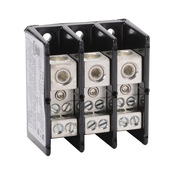illin8
Well-Known Member
Here's a question...follow me on this one. Could you set-up two of these 1-in/4-out power distribution blocks on 2 circuits sharing the same ground on one terminal?


http://www.automationdirect.com/adc/Shopping/Catalog/Power_Products_(Electrical)/Power_Distribution_Blocks/Open_Style,_UL_Recognized,_175A-760A_(PB_Series)/PB1043
Block A: Would service a 110v circuit with L1 (Hot), Neutral, and ground connected to it.
Block B: Would service a 240v circuit with L1, L2, and Neutral connected to it, but have the ground from this circuit shared with the ground on Block A?
Trying to figure out a way of incorporating 2 circuits without making a mess inside the control panel and keeping it clean. Since the 240v circuit is 30 amps and powering a 5,500 watt element, let's assume its a dedicated circuit to the element. Power/control for pumps, PID, HLT stirrer, etc. will be supplied by the 110v circuit rated for 20 amps.
Can one side of the distribution block be used for a ground? Can that ground be shared with other circuits provided the neutral is maintained separately? I'm pretty sure you can but in over-thinking things I always get myself confused...
Also, what size/type wire do you use to wire up the PID? Does it have/need a ground? Should I fuse it?


http://www.automationdirect.com/adc/Shopping/Catalog/Power_Products_(Electrical)/Power_Distribution_Blocks/Open_Style,_UL_Recognized,_175A-760A_(PB_Series)/PB1043
Block A: Would service a 110v circuit with L1 (Hot), Neutral, and ground connected to it.
Block B: Would service a 240v circuit with L1, L2, and Neutral connected to it, but have the ground from this circuit shared with the ground on Block A?
Trying to figure out a way of incorporating 2 circuits without making a mess inside the control panel and keeping it clean. Since the 240v circuit is 30 amps and powering a 5,500 watt element, let's assume its a dedicated circuit to the element. Power/control for pumps, PID, HLT stirrer, etc. will be supplied by the 110v circuit rated for 20 amps.
Can one side of the distribution block be used for a ground? Can that ground be shared with other circuits provided the neutral is maintained separately? I'm pretty sure you can but in over-thinking things I always get myself confused...
Also, what size/type wire do you use to wire up the PID? Does it have/need a ground? Should I fuse it?



